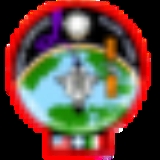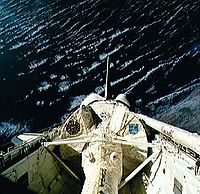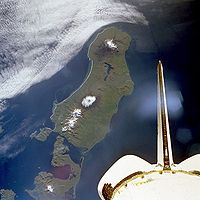
STS-47
Encyclopedia
STS-47 was the 50th Space Shuttle
mission of the program
, as well as the second mission of Space Shuttle Endeavour
. The mission mainly involved conducting experiments in life and material sciences.

 Spacelab-J—a joint NASA and National Space Development Agency of Japan (NASDA) mission using a manned Spacelab module—conducted microgravity investigations in materials and life sciences. The international crew, consisting of the first Japanese astronaut to fly aboard the Shuttle, the first African-American woman to fly in space and, contrary to normal NASA policy, the first married couple to fly on the same space mission (Lee
Spacelab-J—a joint NASA and National Space Development Agency of Japan (NASDA) mission using a manned Spacelab module—conducted microgravity investigations in materials and life sciences. The international crew, consisting of the first Japanese astronaut to fly aboard the Shuttle, the first African-American woman to fly in space and, contrary to normal NASA policy, the first married couple to fly on the same space mission (Lee
and Davis
), was divided into red and blue teams for around the clock operations. Spacelab-J included 24 materials science and 20 life sciences experiments, of which 35 were sponsored by NASDA, 7 by NASA and 2 collaborative efforts.
Materials science investigations covered such fields as biotechnology, electronic materials, fluid dynamics and transport phenomena, glasses and ceramics, metals and alloys, and acceleration measurements. Life sciences included experiments on human health, cell separation and biology, developmental biology, animal and human physiology and behavior, space radiation, and biological rhythms. Test subjects included the crew, Japanese koi fish (carp), cultured animal and plant cells, chicken embryos, fruit flies, fungi and plant seeds, and frogs and frog eggs.
Twelve Get Away Special (GAS) canisters (10 with experiments, 2 with ballast) were carried in the payload bay. Middeck experiments were: Israeli Space Agency Investigation About Hornets (ISAIAH), Solid Surface Combustion Experiment (SSCE), Shuttle Amateur Radio Experiment (SAREX II), Air Force Maui Optical Site (AMOS), and Ultraviolet Plume Imager (UVPI).
Amongst the GAS Cansisters was G-102 Sponsored by the Boy Scouts of America
's Exploring Division in cooperation with the TRW Systems Integration Group, Fairfax, Va. The project was named Project POSTAR
which was the first space experiment created entirely by members of the Boy Scouts of America.
Also on board was were two experiments prepared by Ashford School
in Kent which, at the time, was a girls-only school. The school in the UK who had won a competition run by Independent Television News
. The experiments were contained in G-520. The first one injected a few gram
s of cobalt nitrate crystals to a sodium silicate
to create a chemical garden
in weightless condition. The growths, which were photographed 66 times as they developed, spread out in random directions twisting and in some cases forming spiral shapes. A second experiment to investigate how Liesegang rings
formed in space failed to operate correctly due to friction
in parts of the mechanism. On its return the experiment was exhibited in the London Science Museum.
Space Shuttle
The Space Shuttle was a manned orbital rocket and spacecraft system operated by NASA on 135 missions from 1981 to 2011. The system combined rocket launch, orbital spacecraft, and re-entry spaceplane with modular add-ons...
mission of the program
Space Shuttle program
NASA's Space Shuttle program, officially called Space Transportation System , was the United States government's manned launch vehicle program from 1981 to 2011...
, as well as the second mission of Space Shuttle Endeavour
Space Shuttle Endeavour
Space Shuttle Endeavour is one of the retired orbiters of the Space Shuttle program of NASA, the space agency of the United States. Endeavour was the fifth and final spaceworthy NASA space shuttle to be built, constructed as a replacement for Challenger...
. The mission mainly involved conducting experiments in life and material sciences.
Crew
Backup crew
Mission parameters
- MassMassMass can be defined as a quantitive measure of the resistance an object has to change in its velocity.In physics, mass commonly refers to any of the following three properties of matter, which have been shown experimentally to be equivalent:...
:- Orbiter landing with payload: 99450 kilograms (219,249.7 lb)
- Payload: 12485 kilograms (27,524.7 lb)
- PerigeePerigeePerigee is the point at which an object makes its closest approach to the Earth.. Often the term is used in a broader sense to define the point in an orbit where the orbiting body is closest to the body it orbits. The opposite is the apogee, the farthest or highest point.The Greek prefix "peri"...
: 297 kilometres (184.5 mi) - Apogee: 310 kilometres (192.6 mi)
- InclinationInclinationInclination in general is the angle between a reference plane and another plane or axis of direction.-Orbits:The inclination is one of the six orbital parameters describing the shape and orientation of a celestial orbit...
: 57.0°
Mission highlights


Mark C. Lee
Mark Charles Lee USAF Colonel, is a former NASA astronaut who flew on four Space Shuttle missions. He retired from the Air Force and NASA on July 1, 2001.-Early life:...
and Davis
Jan Davis
Nancy Jan Davis is a former American astronaut. A veteran of three space flights, Dr. Davis has logged over 673 hours in space. Dr. Davis is now retired from NASA.-Early life:She was born in Cocoa Beach, Florida, but considers Huntsville, Alabama, to be her hometown...
), was divided into red and blue teams for around the clock operations. Spacelab-J included 24 materials science and 20 life sciences experiments, of which 35 were sponsored by NASDA, 7 by NASA and 2 collaborative efforts.
Materials science investigations covered such fields as biotechnology, electronic materials, fluid dynamics and transport phenomena, glasses and ceramics, metals and alloys, and acceleration measurements. Life sciences included experiments on human health, cell separation and biology, developmental biology, animal and human physiology and behavior, space radiation, and biological rhythms. Test subjects included the crew, Japanese koi fish (carp), cultured animal and plant cells, chicken embryos, fruit flies, fungi and plant seeds, and frogs and frog eggs.
Twelve Get Away Special (GAS) canisters (10 with experiments, 2 with ballast) were carried in the payload bay. Middeck experiments were: Israeli Space Agency Investigation About Hornets (ISAIAH), Solid Surface Combustion Experiment (SSCE), Shuttle Amateur Radio Experiment (SAREX II), Air Force Maui Optical Site (AMOS), and Ultraviolet Plume Imager (UVPI).
Amongst the GAS Cansisters was G-102 Sponsored by the Boy Scouts of America
Boy Scouts of America
The Boy Scouts of America is one of the largest youth organizations in the United States, with over 4.5 million youth members in its age-related divisions...
's Exploring Division in cooperation with the TRW Systems Integration Group, Fairfax, Va. The project was named Project POSTAR
Project POSTAR
STS-47 Mission PatchGet Away Special LogoProject POSTAR was the first space experiment created entirely by members of the Boy Scouts of America....
which was the first space experiment created entirely by members of the Boy Scouts of America.
Also on board was were two experiments prepared by Ashford School
Ashford School
Ashford School is an independent school in East Hill, Ashford, Kent. For the vast majority of its 111 years of existence it has been a school purely for girls but in 2006 boys were admitted in some year groups and it is now a school for both sexes from the age of 3 to 18 offering boarding and day...
in Kent which, at the time, was a girls-only school. The school in the UK who had won a competition run by Independent Television News
Independent Television News
ITN is a news and content provider with headquarters in the United Kingdom. It is made up of four key businesses: ITN News, ITN Source, ITN Productions and ITN Consulting. The ITN logotype can be displayed in any of 4 different colours, each of which represents a business unit. This is the...
. The experiments were contained in G-520. The first one injected a few gram
Gram
The gram is a metric system unit of mass....
s of cobalt nitrate crystals to a sodium silicate
Sodium silicate
Sodium silicate is the common name for a compound sodium metasilicate, Na2SiO3, also known as water glass or liquid glass. It is available in aqueous solution and in solid form and is used in cements, passive fire protection, refractories, textile and lumber processing, and automobiles...
to create a chemical garden
Chemical Garden
A chemical garden is an experiment in chemistry normally done by adding solid metal salts such as copper sulfate or cobalt chloride to an aqueous solution of sodium silicate . This results in growth of plant like forms in minutes to hours. The chemical garden was first observed and described by...
in weightless condition. The growths, which were photographed 66 times as they developed, spread out in random directions twisting and in some cases forming spiral shapes. A second experiment to investigate how Liesegang rings
Liesegang rings
Liesegang rings are a phenomenon seen in many, if not most, chemical systems undergoing a precipitation reaction, under certain conditions of concentration and in the absence of convection.-History:...
formed in space failed to operate correctly due to friction
Friction
Friction is the force resisting the relative motion of solid surfaces, fluid layers, and/or material elements sliding against each other. There are several types of friction:...
in parts of the mechanism. On its return the experiment was exhibited in the London Science Museum.
See also
- Space scienceSpace scienceThe term space science may mean:* The study of issues specifically related to space travel and space exploration, including space medicine.* Science performed in outer space ....
- Space shuttleSpace ShuttleThe Space Shuttle was a manned orbital rocket and spacecraft system operated by NASA on 135 missions from 1981 to 2011. The system combined rocket launch, orbital spacecraft, and re-entry spaceplane with modular add-ons...
- List of space shuttle missions
- List of human spaceflights chronologically
- Project POSTARProject POSTARSTS-47 Mission PatchGet Away Special LogoProject POSTAR was the first space experiment created entirely by members of the Boy Scouts of America....

